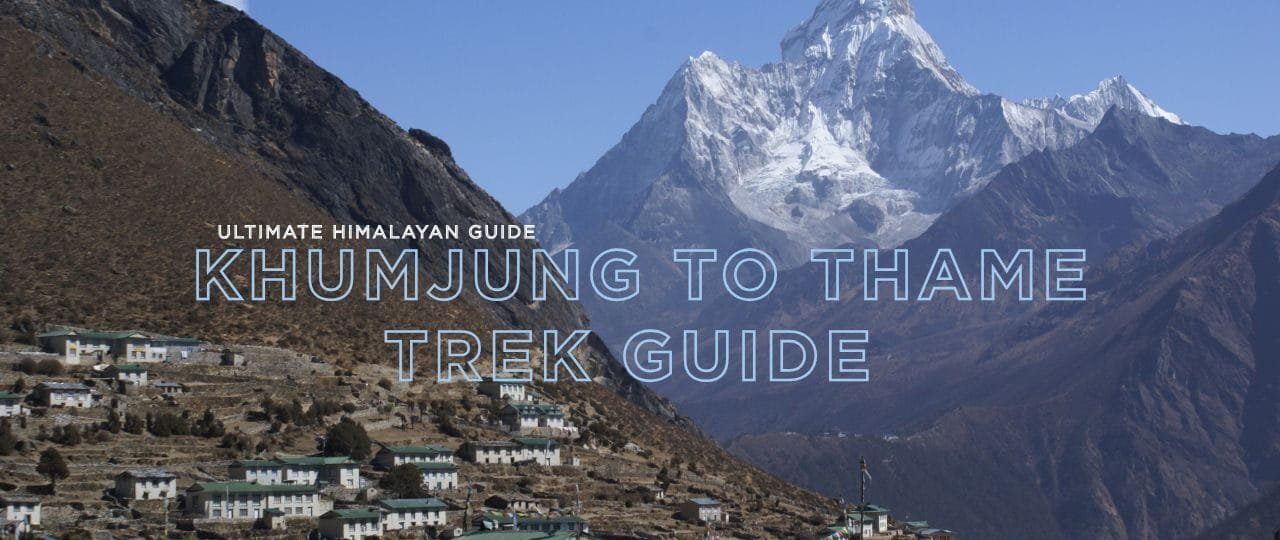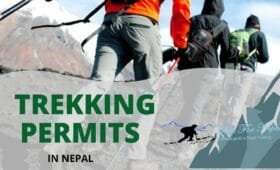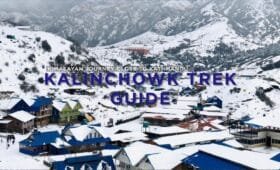The Khumjung to Thame Trek is one of Nepal’s most enriching and culturally immersive trekking experiences. Nestled in the heart of the Everest region, this trek offers breathtaking vistas, intimate encounters with Sherpa culture, and a unique chance to explore the rural life of high-altitude villages. Whether planning a Thame to Khumjung Trek or following a detailed Khumjung Thame Trek Itinerary, this comprehensive guide will prepare you for every aspect of the journey.
In this Khumjung to Thame Trek Guide article, we cover everything from the Khumjung to Thame Trek Itinerary and Khumjung to Thame Trek Cost to route details, difficulty, weather conditions, permits, accommodation, and essential packing lists. With a blend of practical advice, compelling testimonials, and actionable insights from reliable sources, you’ll be well-equipped to embark on the Khumjung to Thame Trek. This trek challenges your physical limits and leaves a lasting impact on your soul. Learn how to support community empowerment through Volunteers Initiative Nepal (ViN).
Introduction
1. Introduction: Why Choose the Khumjung to Thame Trek?
The Khumjung to Thame Trek is more than a physical journey—it’s an exploration of culture, nature, and history in one of Nepal’s most iconic regions. This trek connects two of the region’s most charming villages: Khumjung, known for its warm Sherpa hospitality and cultural heritage, and Thame, a village steeped in Tibetan Buddhist traditions.
Many trekkers opt for the Thame to Khumjung Trek (or vice versa) because it provides a shorter yet advantageous route compared to the longer Everest Base Camp circuits. The moderate altitude, diverse landscapes, and fewer crowds make this trek ideal for both novices and seasoned trekkers who want to experience a slice of Himalayan life without the extreme challenges of higher passes.
“The Khumjung to Thame Trek was a revelation. It allowed me to experience authentic Sherpa culture and stunning mountain vistas in a personal and unhurried way,”
shares Dorje, an experienced trekker from Bhutan.
The trek also serves as a stepping stone for those interested in exploring the Everest region further. Combining cultural immersion with natural beauty, the Khumjung to Thame Trek provides a balanced adventure that appeals to all.
History
2. Historical and Cultural Context
2.1 The Legacy of Khumjung and Thame
Khumjung is a village that has retained its traditional charm despite growing popularity. It is home to the famous Khumjung School and the revered Buddha statue donated by Tenzing Norgay. The village is a hub of Sherpa culture, where age-old customs coexist with modern influences. Meanwhile, Thame is known for its strong Tibetan Buddhist heritage, evident in its monasteries, prayer flags, and traditional festivals.
Both villages have evolved over centuries as centers of spirituality and community life. The Khumjung to Thame Trek offers a window into this rich history and provides an opportunity to interact with locals who maintain these ancient traditions.
2.2 Cultural Immersion Along the Trek
As you traverse the trail between Khumjung and Thame, you’ll pass through terraced farmlands, encounter ancient stone stupas, and witness the daily lives of local families. The trekking route is dotted with small prayer wheels, chortens, and mani stones, each telling a story of devotion and cultural preservation.
“Walking from Khumjung to Thame, I felt like I had stepped back in time. Every village, every stupa, and every smiling face told a story of resilience and deep spirituality,”
recounts Maya, a volunteer trekker from the United States.
This immersive experience is one of the key attractions of the Khumjung to Thame Trek. By interacting with the community and learning about their traditions, trekkers gain insights beyond the physical journey.
Trek Itinerary
3. Detailed Itinerary: The Khumjung to Thame Trek Itinerary
A well-structured Khumjung Thame Trek Itinerary is crucial to enjoying a seamless adventure. Below is a sample itinerary for a 7-day trek, ideal for acclimatization and cultural immersion.
Day 1: Arrival in Kathmandu and Transfer to Lukla
- Transport: Fly from Kathmandu to Lukla (approximately 30–40 minutes).
- Activities: Brief orientation in Lukla; prepare for the trek.
- Overnight: Teahouse in Lukla.
Day 2: Lukla to Phakding
- Trekking Duration: 3–4 hours.
- Highlights: Cross suspension bridges over the Dudh Koshi River; enjoy lush landscapes.
- Overnight: Teahouse in Phakding (~2,610m).
Day 3: Phakding to Namche Bazaar
- Trekking Duration: 5–6 hours.
- Route: Ascend through scenic trails with panoramic views of the Himalayas.
- Highlights: Experience local culture and the vibrant marketplace of Namche.
- Overnight: Teahouse in Namche Bazaar (~3,440m).
Day 4: Namche Bazaar – Acclimatization Day
- Activities: Explore Namche; optional day hike to Everest View Hotel.
- Purpose: Essential acclimatization to prepare for higher altitudes.
- Overnight: Teahouse in Namche.
Day 5: Namche Bazaar to Khumjung
- Trekking Duration: 4–5 hours.
- Route: Gentle ascent to Khumjung, passing through lush forests and terraced fields.
- Highlights: Visit local landmarks like Khumjung School and the Buddha statue.
- Overnight: Teahouse in Khumjung (~3,440m).
Day 6: Khumjung to Thame
- Trekking Duration: 4–5 hours.
- Route: Traverse, a scenic trail that offers breathtaking views and deep cultural immersion.
- Highlights: Reach Thame, a village renowned for its Tibetan Buddhist heritage and ancient monasteries.
- Overnight: Teahouse in Thame (~3,600m).
Day 7: Thame Exploration and Cultural Immersion
- Activities: Explore local monasteries, interact with villagers, and attend cultural events.
- Highlights: Participate in a traditional prayer session, learn about local festivals, and sample authentic Tibetan cuisine.
- Overnight: Teahouse in Thame.
Day 8: Return: Thame to Khumjung and Descent to Lukla
- Trekking Duration: 6–7 hours for the ascent and descent combined.
- Route: Retrace your steps back to Khumjung, then continue to Lukla.
- Overnight: Teahouse in Lukla.
Day 9: Lukla to Kathmandu
- Transport: Early morning flight from Lukla to Kathmandu.
- Activities: Debrief in Kathmandu, do the final souvenir shopping and relax.
- Overnight: Hotel in Kathmandu.
This itinerary provides a balanced mix of trekking, acclimatization, and cultural experiences. The Khumjung to Thame Trek Itinerary is flexible and can be adjusted to suit your pace, making it ideal for those looking for a moderately challenging yeenrichrding Himalayan adventure.
Route
4. Trek Route and Distance Overview
The Khumjung to Thame Trek Distance is approximately 20–25 km one-way, depending on your specific route and any detours you take. Overall, the round-trip journey covers roughly 40–50 km. Although the daily distances are relatively short, the cumulative ascent and descent and variable terrain make the trek moderately challenging.
Key Landmarks Along the Route:
- Khumjung Village: The cultural heart of the region, featuring traditional Sherpa architecture and sacred sites.
- Scenic Trails: The route weaves through terraced fields, dense forests, and rocky outcrops, offering varying vistas at each turn.
- Thame Village: Known for its rich Tibetan Buddhist heritage, Thame provides a glimpse into ancient practices and offers peaceful surroundings perfect for reflection.
Using a detailed Khumjung to Thame Trek Map is essential. Local trekking agencies offer maps highlighting teahouse locations, trail junctions, and elevation profiles—ensuring you can navigate the route confidently.
Trek Difficulty
5. Trek Difficulty and Altitude Considerations
The Khumjung to Thame Trek Difficulty is generally rated as moderate, making it an ideal choice for trekkers who seek an authentic Himalayan experience without the extreme challenges of high-altitude treks like Everest Base Camp. Here are key factors that influence the difficulty:
- Altitude: Khumjung and Thame are around 3,440m to 3,600m. Although these altitudes are lower than many Everest routes, altitude sickness can still affect some individuals.
- Terrain: The route consists of a mixture of gentle slopes, rugged paths, and steep ascents, particularly on the final push from Khumjung to Thame.
- Acclimatization: A rest day in Namche Bazaar is recommended, making the overall difficulty more manageable.
- Physical Endurance: With daily trekking hours of 5–7, maintaining a steady pace and proper hydration is crucial.
The Khumjung to Thame Trek offers a well-balanced challenge for trekkers with moderate fitness levels. Those new to high-altitude trekking should take their time and consider hiring a Khumjung to Thame Trek Guide for added support and local insights.
Costing
6. Budgeting Your Trek: Cost and Package Options
Understanding the Khumjung to Thame Trek Cost is vital for planning your adventure. Costs vary based on your chosen mode of travel, lodging preferences, and whether you opt for guided services or go independently.
Cost Breakdown:
Transportation:
- Kathmandu to Lukla: Approximately USD 180–200 for a round-trip flight.
- Jeep/Bus Options: Some opt for land routes (longer duration, cheaper cost) if available.
Accommodation and Meals:
- Teahouse Lodging: Basic teahouses in Khumjung and Thame cost around USD 3–6 per night at lower altitudes, with slightly higher prices in Thame.
- Meals: Expect to spend roughly USD 20–30 daily for local Nepali cuisine (dal bhat, momos, noodles, etc.).
Permits:
- Sagarmatha National Park Permit: This route is not applicable if it is not extended to Everest Base Camp, but check local requirements.
- Local Municipality Fees: These may apply in some areas; the budget is around USD 20.
- TIMS Card: Approximately USD 10–20 if your trek extends into protected regions.
Guide and Porter Fees:
- Hiring a Khumjung to Thame Trek Guide is optional but recommended. They typically cost USD 25–30 per day.
- Porters, if needed, charge around USD 15–20 per day.
Miscellaneous:
- Hot showers, Wi-Fi, and gear rentals (if necessary) may add an extra USD 2–5 per day.
For a 7–9 day trek, the Khumjung to Thame Trek Cost can range from USD 300 to 600 for budget travelers. For those opting for a guided trek with additional services, packages might range from USD 600 to 900. Always check with local trekking agencies for the latest prices and package details.
Permits
7. Permits and Documentation
While the Khumjung to Thame Trek is not as regulated as the Everest region, some permits and documents are still necessary:
- Local Municipality Permits: A nominal fee (around USD 20) might be required depending on the area.
- TIMS Card: A TIMS card (USD 10–20) might be needed if your trek connects with other protected regions.
- Passport: Always carry your passport and copies, as local authorities may request identification.
Before you set out, check with a Khumjung to Thame Trek Guide or a local trekking agency to ensure you have all the necessary documentation.
Best Timing
8. Weather, Best Time, and Altitude
8.1 Khumjung to Thame Trek Best Time
The ideal time for the Khumjung to Thame Trek is during the autumn (September–November) and spring (March-May) seasons:
- Autumn: Provides clear, crisp weather with minimal rainfall and stunning mountain views. Temperatures are pleasant during the day, though nights can be cold.
- Spring: Offers moderate temperatures, blooming rhododendrons, and vibrant cultural experiences.
- Winter: Fewer trekkers and clear skies, but expect freezing nights and limited teahouse availability.
- Monsoon: Not recommended due to heavy rainfall, slippery trails, and the risk of landslides.
8.2 Khumjung to Thame Trek Weather
The weather along the trek can vary:
- Lower Altitudes (Khumjung): Typically mild and temperate.
- Higher Altitudes (Thame): Cooler, with temperatures dropping close to freezing at night.
- Daytime: Generally comfortable in autumn and spring, but always carry a waterproof jacket.
8.3 Khumjung to Thame Trek Altitude
Khumjung sits at approximately 3,440m, while Thame is around 3,600m. This moderate altitude requires proper acclimatization. Although not highly high, altitude sickness can still occur; thus, it’s essential to maintain a slow pace, hydrate, and rest adequately.
Trek Accommodation
9. Lodging and Amenities
Khumjung to Thame Trek Accommodation is typically provided in teahouses along the route:
- Khumjung: Offers basic teahouse accommodations with shared rooms and communal dining.
- Thame: Slightly more basic, reflecting its remote nature, but still provides essential amenities such as warm beds, hot showers (for a fee), and local meals.
- Overall, Teahouses in this region are known for their warm hospitality and authentic cultural ambiance. Expect to pay modestly—generally between USD 3 and 8 per night—with additional costs for meals and services.
Comfortable lodging is crucial, especially after a long day of trekking. Always carry extra cash in local currency for incidental expenses like charging your devices or paying for a hot shower.
Trekking Tips
10. Essential Trekking Tips and Packing List
10.1 Khumjung to Thame Trek Packing List
Prepare a comprehensive packing list to ensure your comfort and safety on the trek:
- Clothing:
- Thermal base layers
- Fleece or down jacket
- Waterproof and windproof shell
- Trekking pants and moisture-wicking shirts
- Footwear:
- Broken-in trekking boots
- Multiple pairs of trekking socks and gaiters
- Accessories:
- Trekking poles
- Hat, gloves, and sunglasses
- Buff or scarf
- Backpack:
- A comfortable daypack (25-35L) to carry essentials
- Hydration:
- Reusable water bottles or hydration systems and water purification tablets
- Gear:
- Headlamp with extra batteries, camera, power bank, personal first-aid kit, and multi-tool
- Documents:
- Passport, necessary permits (if required), TIMS card, and travel insurance
- Miscellaneous:
- Snacks (energy bars, nuts), travel journal, and extra cash for local fees
10.2 Additional Khumjung to Thame Trek Tips
Keep Your Permits Safe: Carry all permit documents and passport copies, as you may need them at checkpoints.
Acclimatize Properly: Even though the altitude is moderate, ensure you take a rest day in Namche or Khumjung to acclimatize before pushing towards Thame.
Stay Hydrated: Aim for at least 3 liters of water daily, especially during steep ascents.
Plan Your Meals: Teahouse food is hearty but straightforward; consider carrying extra energy snacks for long trekking days.
Respect Local Customs: Always greet with “Namaste” and ask before taking photos of locals or sacred sites.
Prepare for Variable Weather: Even in autumn, nights can be chilly—pack extra layers and a reliable waterproof jacket.
Use Trekking Poles: They significantly reduce strain on steep ascents and descents.
FAQs
11. The Seven Most Frequently Asked Questions
1. What is the total distance of the Khumjung to Thame Trek?
The total trek distance is approximately 20–25 km one-way, with a round-trip distance of roughly 40–50 km, depending on your route and detours.
2. How difficult is the Khumjung to Thame Trek?
The Khumjung to Thame Trek Difficulty is generally moderate. While the elevation difference is modest, the continuous ascent and descent over uneven terrain require good physical fitness.
3. What is the typical duration of the trek?
The standard Khumjung to Thame Trek Duration is 7–9 days, allowing for proper acclimatization and ample time to explore both villages and surrounding landscapes.
4. How much does the trek cost?
The Khumjung to Thame Trek Cost varies but typically ranges from USD 300–600 for budget travelers using teahouse accommodations. Guided packages may range from USD 600–900.
5. Which permits are required for this trek?
Permits for this region are minimal; however, some local municipality fees may apply. Always check with your Khumjung to Thame Trek Guide for the latest requirements.
6. What is the best time to undertake the trek?
The best time to do the Khumjung to Thame Trek is during autumn (September–November) or spring (March), when weather conditions are stable and scenic views peak.
7. Do I need a guide for the trek?
While the route is relatively straightforward, hiring a Khumjung to Thame Trek Guide (approximately USD 25–30 per day) is recommended for enhanced safety, local insights, and assistance with teahouse bookings.
Conclusion
The Khumjung to Thame Trek offers an exceptional Himalayan adventure that combines breathtaking natural beauty, vibrant cultural heritage, and moderate trekking challenges. This route, connecting the historical village of Khumjung with the culturally rich Thame, provides trekkers with a unique opportunity to immerse themselves in authentic Sherpa life. With its manageable distance and moderate difficulty, the trek is perfect for those looking to experience the true essence of the Everest region without the extreme conditions found on higher-altitude routes.
Charity trekking and travel tours
Are you ready to embark on the Khumjung to Thame Trek and make a lasting impact? Join Volunteers Initiative Nepal (ViN) today and transform your trek into a mission of empowerment.
- Share: Encourage your friends, family, and social networks to embrace charity trekking and join this transformative journey.
- Volunteer: Share your skills, knowledge, and time to support local community projects in the Everest region.
- Intern: Combine your professional or academic pursuits with hands-on experience in remote Nepal.
- Donate: Your contributions help fund critical education, healthcare, and environmental conservation projects.
Namaste—let your Himalayan journey be an unforgettable personal achievement and a force for positive change in Nepal.
Practical Guidance
13. Extended Practical Guidance & Final Thoughts
13.1 Seasonal Breakdown & Weather Insights
- Autumn (Sept–Nov): This season offers the clearest skies and most stable weather. Expect cool days and crisp nights—perfect for trekking and photography.
- Spring (Mar-May): Enjoy the vibrant colors of blooming rhododendrons, moderate temperatures, and fewer crowds.
- Winter (Dec–Feb): This period is ideal for solitude, but be prepared for cold nights. Teahouses may offer limited amenities.
- Monsoon (Jun–Aug): Heavy rainfall, slippery trails, and potential delays make this season less ideal.
13.2 Route Alternatives & Detours
While the primary route from Khumjung to Thame is well-marked, some trekkers opt for short detours to:
- Visit local monasteries and cultural landmarks.
- Explore nearby trails that provide additional panoramic views of the Himalayas.
- Extend the trek to include additional villages for a deeper cultural immersion.
13.3 Overcoming Challenges
- Altitude and Acclimatization: Even though the altitude difference is modest, allow for rest days in Khumjung or Namche to acclimatize properly.
- Variable Weather: Pack extra layers and waterproof gear. Be flexible with your schedule in case of weather-related delays.
- Teahouse Capacity: Book in advance during peak trekking seasons to secure your preferred lodging.
13.4 Post-Trek Options
After completing the trek, many adventurers choose to:
- Relax in Kathmandu or Pokhara, reflecting on the transformative journey.
- Explore additional Himalayan routes like the Everest Base Camp Trek or Gokyo Lakes.
- Engage in volunteer projects with ViN to continue contributing to community empowerment.




